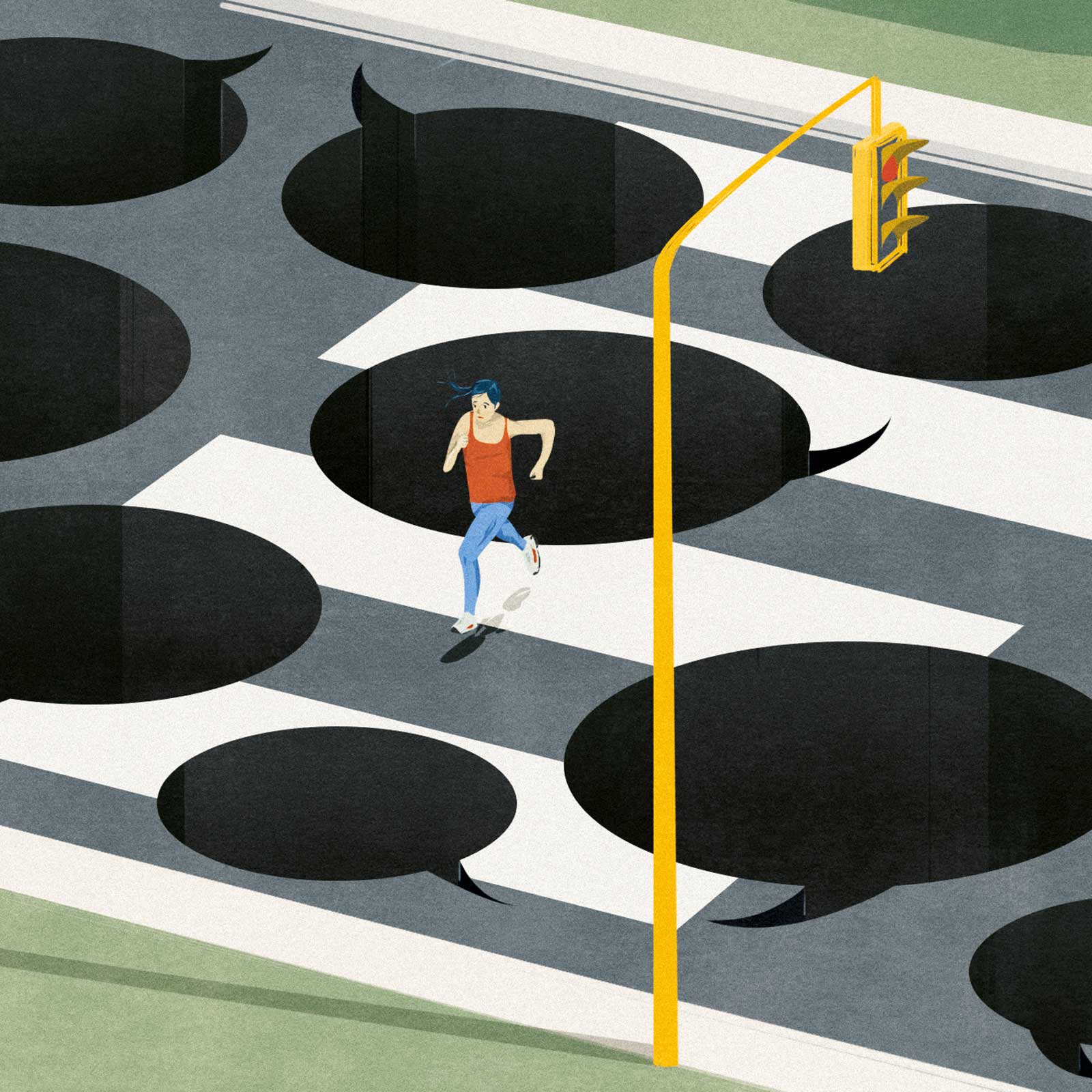In his beloved book , Haruki Murakami appraises a group of girls who run past him: “Most of these girls are small, slim, have on maroon Harvard-logo outfits, blond hair in a ponytail, and brand-new iPods, and they run like the wind. You can definitely feel a sort of aggressive challenge emanating from them.” When a girl runs fast, she’s seen as a threat. In turn, men react competitively. Murakami adds: “Not to brag, but these girls probably don’t know as much as I do about pain.”
Murakami could have been referencing me in this description. I often run past joggers with an aggression that is usually only acceptable for men to exhibit, earbuds firmly in place. After reading Murakami’s take, I realize now that this might be misconstrued as an air of impatience, or maybe superiority. Neither are true. I run fast because I can. But also because when I run fast enough, with my face set in an impenetrable line, I hope it might be enough to convince everyone not to harass me.
But no matter how fast you run, danger can still find you. When I was in high school, I went out for a run and got hit by a car. A few miles from home, without a cellphone and in too much pain to walk back, I asked the woman who hit me to drive me back to my house. Perhaps thinking it was the least she could do, she agreed. While that was probably the most awkward car ride of my life, it was far from the most uncomfortable experience I’ve had as a female runner. Sure, I was shaken and badly bruised. But getting hit by a car on a run is a rarity. Street harassment, on the other hand, happens regularly enough that it feels rational to fear it.
My experience with harassment started early. I began running when I was eight years old, competing on my school’s cross-country and track teams. During lunch and after school, I ran loops around the block to practice for races. Underdressed in shorts and a T-shirt on a particularly cold day in late fall, I was racing around the block at full speed. Thoughts of the warm changing room motivated me to run faster. Halfway through my second loop, an elderly man turned his head and spat at me.
With all due respect to Mr. Murakami, I’m sure I know just as much about pain as he does.
I stopped running, darted back into school, and approached my fourth-grade teacher in tears—forfeiting my attempt at a personal best. My teacher assured me that it was impossible to know if the man had done it on purpose. She was sure that he hadn’t. But the fact still stands that he spat in my direction, grazing my bare leg. In my memory, he was scowling. Was he offended by my outfit? Or simply the fact that a young girl had the audacity to compete?
When I was 12 years old, my cross-country coach had a history of erratic behavior toward his female athletes that bordered on bullying. One day, he kicked a puddle of water at me during an after-school run, soaking the entire side of my running tights with dirty water. The action was unprovoked, but in the context of his overall behavior, it didn’t come as a surprise. Blind with anger, I ran back to the school by myself, changed, and walked home alone.
My graduation from the three-kilometer loop of elementary and middle school competition to the five-kilometer sprint of high school races also marked a separate, unwelcome shift: The harassment became sexual. It feels almost pointless to say, but I was frequently catcalled, as every female runner has been. The experience of being catcalled is always unsettling. It forces your brain into overdrive. You quickly review every possible threat and create an escape plan. Do I acknowledge the harasser? Run faster? Stop running?
Throughout my years of running, the catcalls have included honks (distracting); “Run, Forrest, Run!” (annoying); and crude remarks about my body (terrifying). And drive-by remarks are just the tip of the iceberg. There are also the drivers who slow down to idle next to me, or the men who roll down their windows at red lights to heckle me. I once had a doughnut thrown at me.
So, with all due respect to Mr. Murakami, I’m sure I know just as much about pain as he does. That “aggressive” stride is a protective sheath.
In the book, Murakami writes that he practices two habits while running: listening to music (“Today I ran for an hour and ten minutes, listening on my Walkman to two albums by the Lovin’ Spoonful—Daydream and Hums of the Lovin’ Spoonful.”) and attempting to clear his head (“I just run. I run in a void…the thoughts that occur to me while I’m running are like clouds in the sky.”) Neither of these activities are possible for me when running. I do run with earbuds in—with the hope that no one will approach me—but I don’t listen to music, so I can be fully aware of my surroundings.
When Murakami talks of suffering, he’s referring to physical pain. I know that kind of pain; all runners do. What Murakami doesn’t know is the emotional pain of anticipating harassment, inventing ways to avoid the inevitable, and imagining worst-case scenarios. I don’t blame Murakami for his ignorance, but maybe I’m jealous of him. It must be nice to go on a long run and allow your mind to become a void.


